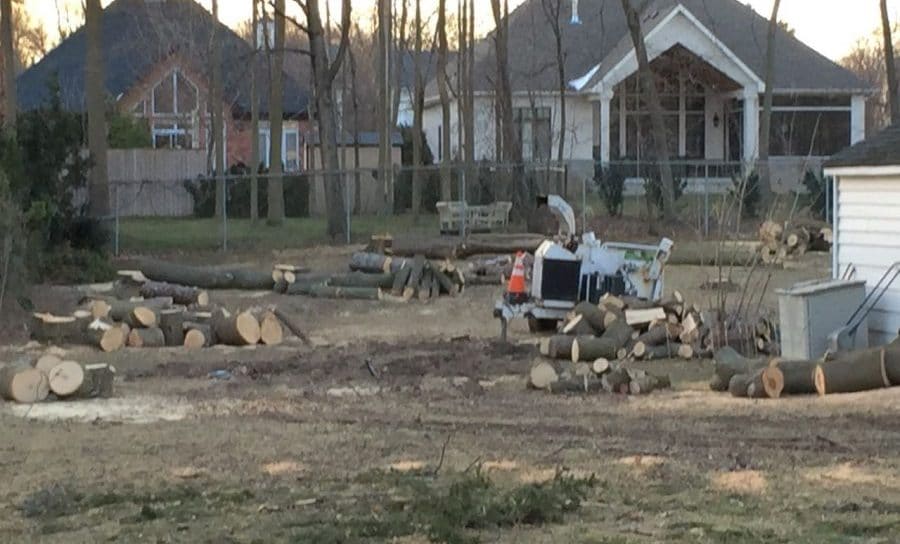
More than 1,000 Garden Making readers took the time to answer our recent survey about municipal tree protection bylaws, with 375 providing comments. To analyze the results, we’ve grouped the 1,064 replies by whether they knew if their town has a tree bylaw (39%), didn’t know (40%) or there is no bylaw (21%), and then compared the results and comments.
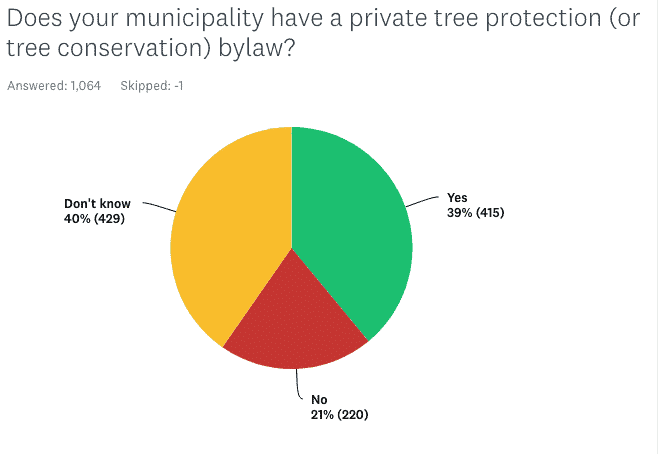
Across all groups, concern about the environment is the primary reason people are motivated to think about tree bylaws. When asked to pick up to three reasons from a list of six choices, 81% selected “Trees are important to our environment.”
The other top two choices cited are the tree canopy of the community and putting a value on trees as part of the community’s heritage. Only 49% thought that a tree protection bylaw forces people to think twice about cutting trees and only 41% think that it encourages new trees to be planted.
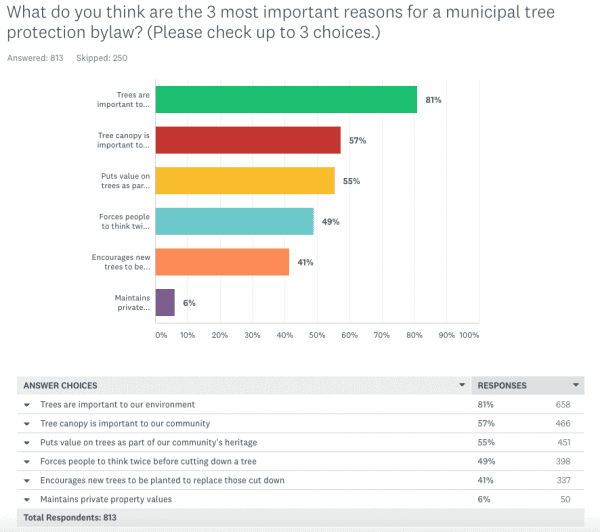
While most of the responses were from Ontario, we heard from people in more than 400 communities across Canada. Many have the same anxiety about trees being cut down.
“When we first bought our home in this neighbourhood, there were a number of mature trees that acted as selling features for us,” says a resident of Medicine Hat, Alberta. “Sadly, many of them have been cut down in the last few years. For us, this makes our neighbourhood less desirable to live in, and it is a factor in considering relocation. My heart races whenever I hear a chainsaw and I worry that another majestic tree is being killed.”
From Port Perry, Ontario: “Recently, many trees in our town have been cut to make way for building more houses. It would have been possible to leave some of these mature trees that took years to grow. No consideration for how trees improve air quality, and have so many other important benefits to our environment.”
“My neighbourhood is drastically changing as developers have discovered our charm,” says a respondent in Ottawa. “However, the developers and their clients are not respectful of the existing ‘feel.’ Houses that are too big are being built and consequently gardens with their mature trees are disappearing. Those of us who cherish the traditional style of our neighbourhood are saddened by what is happening.”
Bylaw effectiveness
Among the 406 who said their community has a tree protection bylaw, we asked about their impression of the effectiveness of their tree protection bylaw. Keeping in mind that we are reporting on people’s impressions, only 26% said that the removal of trees seems to follow the bylaw process while 38% said some people ignore the bylaw and get away with it.
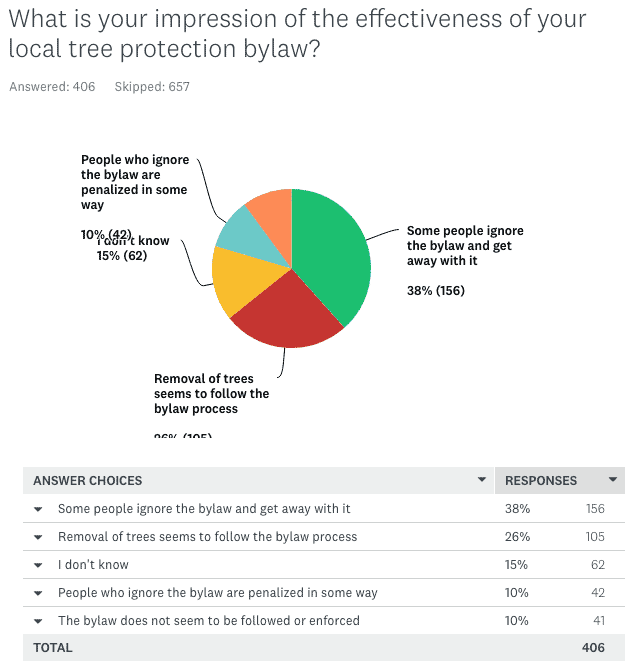
Several readers provided links to municipal bylaws, with comments about the complexity of the process.
“I approve of the bylaw, but some aspects are silly,” says a resident of Abbotsford, British Columbia. “It requires that for every tree cut down, 3 new ones must be planted. It sounds great in theory, but I know of a case where there was not room for 3 trees on that particular city lot.”
A respondent in Vancouver says: “Vancouver bylaws have had some impact on indiscriminate cutting down of trees, as well as having a strong replanting program on both public and private property. There are, however, problems with private individuals and property developers finding ways to circumvent bylaws and/or ignoring those bylaws altogether. Sometimes nothing is done, sometimes fines are imposed, but seem to have little effect given the costs of property in the city (fines sometimes seen as merely part of the cost of developing a property.)”
Several residents from Oakville, Ontario, commented on tree protection efforts. “Any serious tree bylaw needs to be accompanied by sufficient inspectors and arborists. And planners have to stop allowing variances that enable the destruction of healthy trees for no reason other than the desire for huge homes. Protecting trees is difficult. Demolition and new builds seriously impact the health and viability of allegedly protected trees.”
The case for a tree bylaw was articulated by a respondent in King City, Ontario: “Trees are extremely important in many ways – oxygen, filtering the air, health and well-being; provide habitat and food for thousands of species of living things; roots stop erosion, help retain moisture and water during drought; mitigate flood conditions; aesthetic beauty; contribute to heritage. A tree preservation bylaw is very helpful in providing direction for property owners in the wise stewardship of trees and highlights the value of trees.”
A number of people are simply opposed to any governmental regulation affecting their personal property.
“Even though I feel a tree policy is a good idea, I’m always afraid they will carry it too far,” says a respondent in Sarnia, Ontario. “If a land owner strongly feels the need to remove a tree, they should be able to do it. It could mean replacing it with a new one somewhere on their property.”
The interest in tree canopy extends to rural areas as well. In Picton, Ontario, a group called Tree the County is trying to protect the existing tree canopy in the county. “We are hoping to work with the local municipality on drafting a new tree policy that will ensure the preservation of old trees and replacement of trees that need to be removed. It has proven to be a difficult process.”
Others are critical of their local town for not looking after trees on public property. Many expressed horror at the so-called tree-trimming practices used to protect hydro lines from tree limbs.
“In several cases, the city itself ignores its own tree bylaws, clear-cutting whole woodlots for parking lots, etc.,” says a respondent in Markham, Ontario.
“The city doesn’t set a good example as it removes a lot of trees for convenience,” says a respondent in London, Ontario.
“When they fix roads, they first cut down the trees and that ruins the ambiance of the area,” comments a respondent from Gananoque, Ontario.
Sometimes, the consideration of a tree bylaw can be lethal to trees.
“Our municipality had a proposed tree cutting bylaw and before it was considered by Council, many property owners had a large number of trees cut down. Council didn’t pass the bylaw and now we have no protection and have lost a lot of mature trees,” says a respondent in Orangeville, Ontario.
A number of people said they opposed the idea of a tree bylaw because it might prevent them from removing an old over-grown tree that had become dangerous. However, most bylaws include criteria that allow for the removal of trees in such circumstances.
“I hate to see the canopy destroyed, but I disagree with government regulations on trees on private property,” says one resident of Hamilton, Ontario.
Also in Hamilton, another respondent says, “The environmental activists and advocacy groups tend to focus on motherhood stuff like planting trees in parks and brownfields, giving away free trees, promoting native trees. Going for a tree bylaw would probably be divisive and I think our enviro groups fear losing support by going against the property rights mentality, which is firmly entrenched here. There is so much work to be done and this heavy-hitting stuff is not high priority. Also, arborists fear that the mere mention of an impending tree bylaw would cause an avalanche of tree-felling, as homeowners cut now while they still can.”
One general impression from looking at the range of comments is that people are most concerned about the impact and pressures of larger-scale property development, but these activities seem to bypass the tree bylaw process because the tree bylaws are targeted more at individual property owners.
Certainly, people do feel that they can have some influence over their local government. In the survey, 60% said they think they can affect local government a great deal or a moderate amount.
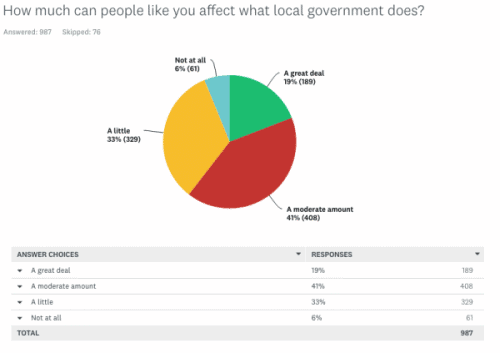
Protecting trees during construction
Tree protection when there is construction is also important, several people commented.
“Aurora has a tree cutting bylaw. But that is what it is, it has rules for cutting trees, but it is not part of an overall tree protection and preservation program,” says a respondent in Aurora, Ontario.
“My concern is politicians are unaware of current scientific opinion about exclusion zones around trees in (re)development areas,” says a resident of Mississauga. “The current zones protect the tree and its bark for sure, but there is now opinion that the feeder roots closer to the surface and farther away from the tree need more protection from heavy machinery than the larger and often deeper roots close to the trunk. The current exclusion zones route heavy machinery directly onto the area which is most at risk. Not sure what can be done about that, as access to the site will be required, however I would like to see the landowner required to provide remedial treatment to the fine root area once construction is complete.”
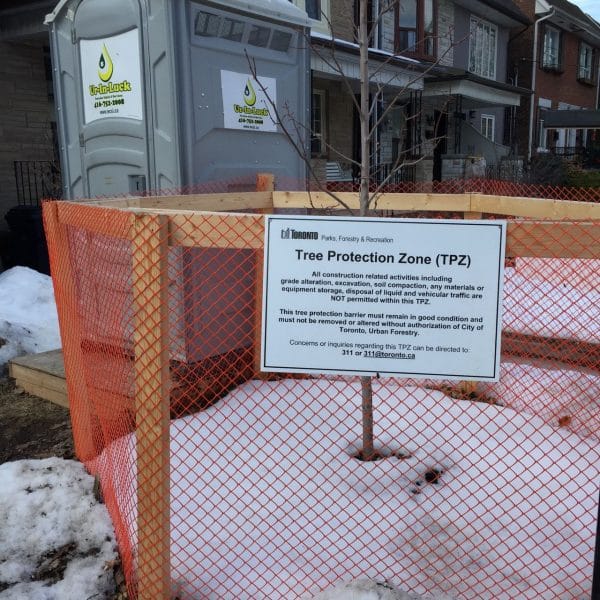
Influencing new trees
“Municipalities could be a positive influence on the type of tree chosen for a suburban lot,” says a respondent in Ottawa. “People are quick to cut trees that have outgrown the space or are seen as problems. They don’t replace these trees with a better choice, resulting in neighbourhoods with lots of houses, big driveways and no trees.”
Several people commented on the LEAF (Local Enhancement and Appreciation of Forests) organization in Toronto with its backyard tree planting program that offers native trees and shrubs to property owners at a subsidized cost. LEAF also provides educational information about caring for new trees.
“Our municipality (for residents only) has a heavily subsidized native tree sale on Earth day annually,” says a respondent in Georgetown, Ontario. “They have had a cull of invasive species recently.”
From Athens, Ontario: “I was responsible for obtaining Council’s consent and organizing funding for a tree inventory in my community. This helped to educate Council to the need to replace the over-mature maples lining our streets, which were dying. We now have an annual program which provides 6- to 7-foot maple trees to residents for $20 each, for planting in their front yards. They pledge to water their tree for the first two years after planting.”
A respondent in St. John’s, Newfoundland, says: “Encouraging more communities to participate in Communities in Bloom programs would increase awareness, understanding and appreciation of the importance of urban forests and supporting bylaws to protect and manage.”
Final observations
We did not expect our survey to be necessarily representative of public opinion because we primarily polled people on our email lists or our website visitors. Several people were critical of the design of the survey or its emphasis on bylaws rather than on a wider range of options for tree preservation and appreciation.
However, with increasing property development pressures coupled with the loss of thousands of trees to diseases and insects such as the emerald ash borer, anxiety about the local tree canopy is obviously closer to home for more people.

And another thing …
Have you ever wondered why so many more folks are affected by seasonal allergies that a few decades ago? It appears that blatant sexism is at play here. Female trees produce fruit – fruit that eventually drop and make a serious mess of the surroundings. Male trees on the other hand do not leave such a visible mess behind. No, what the male trees do is produce volumes of pollen that will make you sneeze, itch and be generally miserable. Many municipalities have over the years opted to remove the messy female trees and replace them with the cleaner male of the species that line their streets and populate parks and schoolyards. Newer developments are often landscaped with male clones from the outset.
Here is another opportunity for residents to influence change that will make our communities healthier.
Look up ” SAFE Gardening” and “OPALS (R)” a system of rating plants based on their tendency to cause allergic reactions. Take the info to your municipal council, public works department, school board, etc. – the folks who are choosing the plants. Please lobby your municipality for a policy on allergy-friendly landscaping. Guidelines for allergy friendly landscaping ought to be a part of any tree bylaw, IMHO and I sincerely hope it will become standard. I know I would get a visit from the MNR or the municipal bylaw enforcement officer, PDQ, if I had a yard full of ragweed, wild chervil or giant hogweed.
We own a sloped rural residence in a county in Ontario that does have a tree bylaw. What we don’t have is a bylaw with teeth. It contains no real consequences for offenders and provides no recourse to residents who are affected by contraventions. Three years after moving into this property the farmer from whose field a row of 10 residential lots were severed, ours included, applied to clear cut 6-8 acres of mature maple for the stated purpose of converting to cornfield. In order to bolster his case, he neglected to mention those 10 adjacent residential lots, although he clearly knew about them, instead claiming that agricultural properties up to a kilometer away were the adjacent properties, effectively camouflaging the residential properties that might have elicited some concern. The county had not vetted this application before approving it nor did it conduct the site inspection that the application form clearly stated would be necessary before the application could be approved. The county did nothing to help us and the other 9 property owners despite our multiple complaints and pleas as the cutting progressed. The county warden did finally visit on the last day of cutting. Too little, too late. By then the trees were gone.
Furthermore, every single one of our trees that shared space with the neighbouring property was removed including a 30″ wide healthy maple whose exposed roots extended into the cutting area. We were told the felled trees were being salvaged for firewood. Trees that size make for pretty expensive firewood if you take going hardwood prices into consideration. I didn’t believe for a minute that these trees were destined for firewood. There are a lot of managed forests in this area whose owners understand the value of sticking to the rules.
We sought legal advice and the opinion was that, although our neighbour was a jerk, that in itself was not illegal. The additional legal advice was that both the county and the neighbour had indeed blatantly contravened the bylaw and that, if we had the appetite to outlast our opponents in litigation, we would most likely win. I must mention that this was in March and we were now downhill from a field missing the stand of trees that would have sucked up several thousand gallons of water per day. That water was by then gushing onto 10 properties, obscuring basement windows, flooding septic beds and washing out driveways and landscaping. Instead of throwing money at a lawyer and risking becoming pariahs in the community we opted to regrade our property, build a berm and install a French drain the width of our 1.5 acre lot to shunt the run-off to a hollow away from the house and septic bed to the tune of nearly $20,000. We still experience some flooding but at least it runs away from the house. I must also mention the asthmatic next door to us being rushed to the hospital many times over the course of a growing season whenever this farmer is seeding or spraying his crops.
It would not have taken a very deep stand of remaining trees to prevent these outcomes of the clear cutting. Our municipal bylaw enforcement officer (not county, at which level the tree bylaw exists) ordered the offending property owner to install a swale on his property to contain thewater running off his fields and to mitigate the potential for damage to adjacent properties. Our municipality does have a bylaw that restricts a property owner from engaging in activities or creating situations that may cause damage to another resident’s property or person. That was 7 years ago and, so far, there is still no swale.
We also had our home evaluated after the cutting was complete and were advised that the value of our home would be 1/4 to 1/3 less than it was before the trees were removed.
Long story short: If you think a tree bylaw will protect you, your trees or your property, you may be very disappointed. On the other hand, you may be bound by a tree bylaw that is unbelievably restrictive and unfair. There is very little consistency from jurisdiction to jurisdiction. Then there is the wide disconnect between county and municipal bylaws, some of which may, in fact, oppose each other. I would advise all property owners to become very familiar with the terms of all bylaws that might affect your home. And, ask question and raise a stink if you uncover something that just isn’t right. The stink we raised did result in a new tree bylaw, not a perfect bylaw but it is better than the previous one.
Thank you for conducting the survey and review. We do have a tree by law. One that, according to the arborist prevented him from cutting any branch greater than 4 inches in diameter without a permit.! The issue is the permitted size of houses. When they could only occupy 1/3 the lot, there was lots of room for mature trees and shrubs. Urban forests in Vancouver back yards flourished. They are being cut down now to provide 6bedroom 7 bathroom homes for people who come from cultures where trees are regarded as a dangerous nuisance in an urban environment. A whole block of newly planted street trees was cut down one night by one such resident. Most developers treat the tree by law as a cost of business. You cannot replace a mature Douglas fir with a 15ft crabapple, yet those are the plans that are approved.